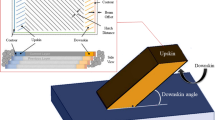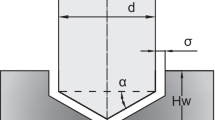Abstract
Pad conditioning is an important process for the improvement of tool removal characteristics by controlling tool surface conditions. This paper presents an experimental investigation, which attempts to reveal the influencing mechanism of pad conditioning on the tool removal characteristics in bonnet polishing process. By assistance of a dynamometer, a microscope, a laser displacement sensor, and a pressure distribution mapping system, multi-comparative group experiments are carried out to establish the correlation of pad conditions, polishing forces, and tool removal characteristic before and after pad conditioning. Through the experiments, three influencing mechanisms are identified: (1) the asperities of the tool surface become smaller and sharper after conditioning, which indicates that the real contact area between the polishing tool and the workpiece reduces, and the coefficient of friction (COF) increases as well, both leading to the improvement of tool removal efficiency; (2) the size of the asperity is determined by the granularity of the conditioner, for which the smaller the conditioner granularity is, the smaller the asperity will be, leading to the decrease of the real contact area; (3) the contour error of bonnet is improved after pad conditioning, so that the periodic amplitude of the polishing forces reduces and the symmetry of the tool influence function (TIF) becomes better. The influencing mechanism identified in this paper can be further served as critical foundation for the investigation on material removal determination through the optimization of pad conditioning process.
Similar content being viewed by others
References
Bingham RG, Walker DD, Kim DH, Brooks D, Freeman R, Riley D (2000) A novel automated process for aspheric surfaces. Proc SPIE, the International Symposium on Optical Sci Technol, 4093: 445–448
Li HY, Walker DD, Yu GY, Sayle A, Messelink W, Evans R, Beaucamp A (2014) Edge control in CNC polishing, paper 2: simulation and validation of tool influence functions on edges. Opt Express 21(1):370–381
Walker DD, Brooks D, King A, Freeman R, Morton R, McCavana G, Kim S (2003) The ‘precessions’ tooling for polishing and figuring flat, spherical and aspheric surfaces. Opt Express 11(8):958–964
Walker DD, Beaucamp ATH, Bingham RG, Brooks D, Freeman R, King SW, King A, McCavana G, Morton R, Riley D, Simms J (2003) Precessions aspheric polishing: new results from the development programme. Proc SPIE, Optical Manufacturing and Testing V (5180):15–28
Dunn CR, Walker DD (2008) Pseudo-random tool paths for CNC sub-aperture polishing and other applications. Opt Express 16(23):18942–18949
Yu GY, Walker DD, Li HY (2012) Research on fabrication of mirror segments for E-ELT. Proc SPIE, 6th International Symposium on Advanced Optical Manufacturing and Testing Technologies 8416:841602
Zeng S, Blunt L (2014) An experimental study on the correlation of polishing force and material removal for bonnet polishing of cobalt chrome alloy. Int J Adv Manuf Technol 73(1–4):185–193
Zeng S, Blunt L (2014) Experimental investigation and analytical modelling of the effects of process parameters on material removal rate for bonnet polishing of cobalt chrome alloy. Precis Eng 38:348–355
Zeng S, Blunt L, Racasan R (2014) An investigation of the viability of bonnet polishing as a possible method to manufacture hip prostheses with multi-radius femoral heads. Int J Adv Manuf Technol 70(1–4):583–590
Beaucamp A, Namba Y, Inasaki I, Combrinck H, Freeman R (2011) Finishing of optical moulds to λ/20 by automated corrective polishing. CIRP Ann Manuf Technol 60:375–378
Zhong B, Chen XH, Pan R, Wang J, Huang HZ, Deng WH, Wang ZZ, Xie RQ, Liao DF (2017) The effect of tool wear on the removal characteristics in high-efficiency bonnet polishing. Int J Adv Manuf Technol 91:3653–3662
Park K, Park J, Park B, Jeong H (2008) Correlation between break-in characteristics and pad surface conditions in silicon wafer polishing. J Mater Process Technol 205:360–365
Li ZC, Baisie EA, Zhang XH (2012) Diamond disc pad conditioning in chemical mechanical planarization (CMP): a surface element method to predict pad surface shape. Precis Eng 36(2):356–363
Zhou YY, Davis EC (1999) Variation of polish pad shape during pad dressing. Mater Sci Eng B68:91–98
Yang JC, Choi JH, Hwang T, Lee C, Kim T (2010) Effects of diamond size of CMP conditioner on wafer removal rates and defects for solid (non-porous) CMP pad with micro-holes. Int J Mach Tool Manu 50(10):860–868
Lee ES, Cha JW, Kim SH (2013) Evaluation of the wafer polishing pad capacity and lifetime in the machining of reliable elevations. Int J Mach Tool Manu 66:82–94
JEONG H, LEE H, CHOI S, LEE Y, JEONG H (2012) Prediction of real contact area from microtopography on CMP pad. J Adv Mech Des Syst 6(1):113–120
Acknowledgements
We appreciate the invaluable expert comments and advices on the manuscript from all anonymous reviewers.
Funding
This work was financially supported by the Science Challenge Project (No. JCKY2016212A506-0502), the National Nature Science Foundation of China (No. 51705011), and the Youth Talent Fund of Laser Fusion Research Center, CAEP. (No. RCFCZ1-2017-6).
Author information
Authors and Affiliations
Corresponding author
Rights and permissions
About this article
Cite this article
Zhong, B., Huang, H., Chen, X. et al. Impact of pad conditioning on the bonnet polishing process. Int J Adv Manuf Technol 98, 539–549 (2018). https://doi.org/10.1007/s00170-018-2250-0
Received:
Accepted:
Published:
Issue Date:
DOI: https://doi.org/10.1007/s00170-018-2250-0




